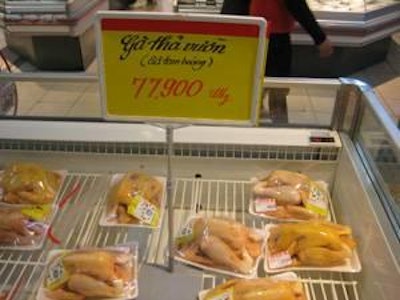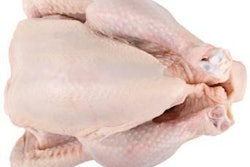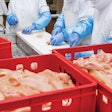
Globalization of the food supply can impact food safety from both a public health and international trade perspective, but insufficient data exist to develop internationally recognized standards. The presence of Salmonella on poultry is an important factor in protecting public health and facilitating trade.
The Codex Alimentarius Commission was established by the Food and Agriculture Organization of the United Nations and the World Health Organization in 1963 to develop harmonized international food standards, guidelines and codes of practice to protect the health of the consumers and ensure fair trade practices in the food trade. Codex Alimentarius standards are established based on risk analysis of scientific food safety data that are available internationally.
The development of internationally recognized food safety standards for poultry will require the collection of data. For example, there are limited data on Salmonella on raw chicken meat. Data obtained from equivalent testing methods on the occurrence of Salmonella on raw chicken are not available for many countries, which limits the ability for Codex Alimentarius to set standards that are representative for poultry production worldwide.
Lack of internationally agreed upon standards can impact the ability of countries to develop science-based standards, which may have a negative impact on trade. Some countries have established a zero-tolerance policy for Salmonella in raw poultry, which is an unrealistic standard in most parts of the world.
Data collection in emerging poultry production markets
The authors conducted a series of studies to determine the prevalence (i.e., frequency) of Salmonella on raw chicken meat at retail establishments in four countries (China, Colombia, Russia and Vietnam) that currently have a Salmonella zero-tolerance policy on raw chicken. The goals of the project were as follows:
- Provide capacity building in these countries on how to build a surveillance system for Salmonella on raw poultry
- Increase the knowledge of the baseline levels of Salmonella in raw poultry in these countries
- Provide data that could be used by World Health Organization and Food and Agriculture Organization in international risk assessments
- Develop internationally recognized standards for Salmonella on raw chicken meat
The long-term goals were to protect the global food supply from contaminants, facilitate fair trade practices and enhance food safety data collection and risk assessment at the local level.
Frequency of Salmonella on raw poultry in retail establishments
In China, Colombia, Russia and Vietnam, approximately 1,000 whole chicken carcasses (locally produced, not imported) were collected from different types of retail markets (hypermarkets, supermarkets, mini-markets and open/wet markets) over a wide geographical region. Using a statistically based sampling plan, the number of samples was determined based on percentage of chicken consumed (correlated with population size) in each country. Subsequently, a stratified sampling strategy was applied in which province and city, district, and store type were the primary, secondary, and tertiary units, respectively.
Frozen chicken was generally less frequently contaminated with Salmonella compared to chicken stored at chilled (4C to 8C) or ambient (greater than 15C) temperatures.
The overall Salmonella prevalence for each country is presented in Table 1. The prevalence by retail market varied greatly in each country, which may be attributed to the contamination at various points in the supply chain, from live chickens on the farm to the storage conditions (chilled, ambient or frozen) at the retail market. The full publications for the China, Colombia, Russia and Vietnam studies are available in the Journal of Food Protection: JFP 74: 1724–1728 (2011); 75: 1134–1138 (2012); 75: 1469–1473 (2012); and 75: 1851–1854 (2012).
All samples were tested for the presence of Salmonella using a whole chicken rinse method recommended by the United States Department of Agriculture, Food Safety and Inspection Service.
To compare these findings with results from other studies, one must consider the differences in study design, number of samples assayed, microbiological analytical unit (whole chicken versus chicken parts), Salmonella isolation methodology, retail store type storage conditions, and food safety practices of poultry production and processing facilities.
Prevalence of Salmonella on poultry in retail establishments
Taking these factors into consideration, the prevalence of Salmonella at retail establishments in countries that have implemented Salmonella control programs at the production and processing levels was as follows:
- 4 percent (n= 877) in the United Kingdom
- 3 percent (n = 232) in New Zealand
- 4.2 percent (n = 212) in the United States
- Zero (n = 40) in Sweden
Alternatively, Salmonella prevalence on raw poultry in countries with limited Salmonella controls in their poultry production and processing practices was as follows:
- 60 percent (n = 60) in Portugal
- 36 percent (n = 772) in Belgium
- 35.8 percent (n = 198) in Spain
- 57 percent (n = 72) in Thailand
The authors are currently collecting enumeration data on the levels of Salmonella on raw poultry in these countries. Quantitative data will enhance our understanding of the risk of acquiring salmonellosis through consumer exposure to raw chicken meat and determine what could be an appropriate quantity of Salmonella on chicken carcasses that would pose a minimal risk to human health. We are also serotyping Salmonella isolates from chicken carcasses and determining their antimicrobial susceptibility profiles.
What do these data tell us?
Salmonella is frequently found on raw poultry, but interventions can be used to reduce the prevalence at a low frequency. Reducing the levels of Salmonella on raw poultry should lead to a reduction in salmonellosis. A zero-tolerance policy on raw chicken meat is an unrealistic goal under the current poultry production and processing systems, but countries should strive to reduce the levels as far as possible.
Data developed in these studies can be useful for the development of common international standards for Salmonella on raw poultry by the Codex Alimentarius Commission. Such information may also be helpful for national governments and industry to identify intervention opportunities as well as control points in poultry production and processing in the surveyed countries to reduce Salmonella contamination at the retail level.
References:
Codex Alimentarius Commission (CAC), 2007. Principles and guidelines for the conduct of microbiological risk management (MRM), CAC/GL 63-2007
WTO 2012; https://www.wto.org/english/tratop_e/sps_e/spsagr_e.htm

















